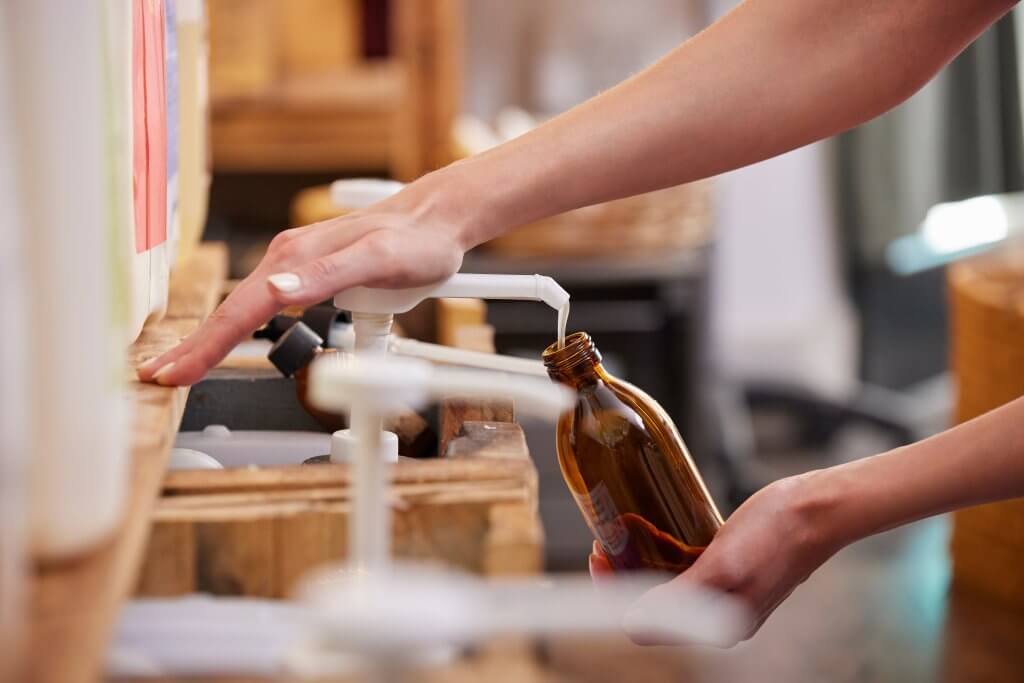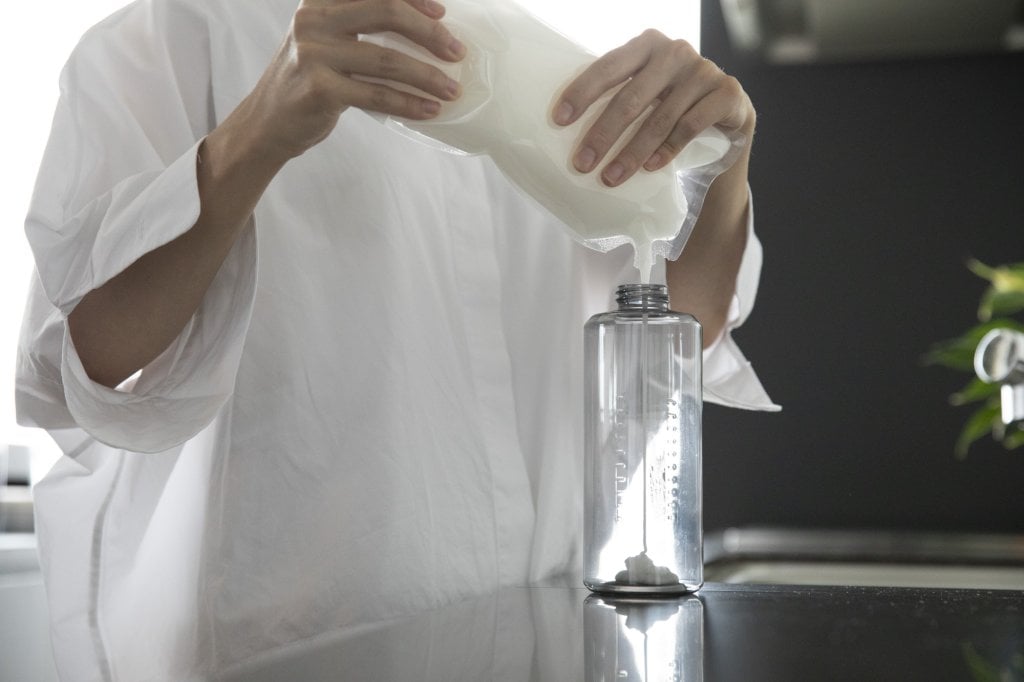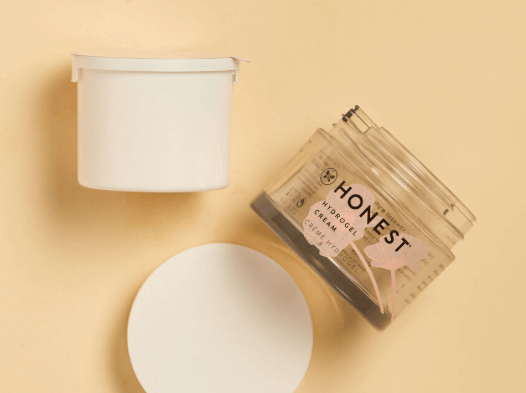As sustainability becomes a key priority for consumers and businesses, refill packaging has emerged as a promising solution to reduce waste and environmental impact. Enter refill packaging – a game-changer in product replenishment; refill options are reshaping how we consume and reuse products. In this blog, we’ll delve into three popular types of refill packaging: in-store refills, refill pouches, and bottle-in-a-bottle refills. By understanding each type’s unique features and benefits, businesses can make informed decisions to embrace eco-friendly packaging practices.
Refill Packaging 1: In-Store Refill Stations – The Buying Experience
Many industries are experiencing a shift towards sustainability, with in-store refill concepts emerging as a solution to reduce packaging waste. In-store refill stations allow consumers to bring their own containers and refill them with their favorite products.

Benefits:
- Encourages reusable container use
- Promotes sustainable shopping habits
- Offers customization options and flexibility for consumers to choose the quantity of products they need
Challenges:
- Requires investment in infrastructure to maintain refill stations
- Consumer education and awareness are essential
- Hygiene and sanitation protocols must be enforced to ensure safety and integrity
In-Store Refill Stations Practice Tips:
Transparency about hygiene measures and quality assurance protocols can alleviate concerns and enhance consumer confidence. Moreover, refill stations must adhere to regulatory guidelines regarding product labeling, ingredient listing, and packaging materials. Collaborating with regulatory authorities and industry experts can help navigate compliance issues and ensure adherence to legal requirements.
Refill Packaging 2: Refill Pouches – Convenience Meets Sustainability
Refill pouches, also known as refill packs or refill bags, have emerged as a popular choice for replenishing products like laundry detergents, dish soaps, and personal care products. These lightweight, flexible pouches are designed to be easily emptied into existing product containers, eliminating the need for new packaging with each purchase.

Benefits:
- Convenience for consumers to refill at home
- Cost-effective and space-saving packaging solution
- Reduces plastic waste and environmental footprint
- Brand loyalty through refillable product lines
Challenges:
- Packaging must provide adequate protection and preservation for the product
- Dispensing functionality should ensure accurate portion control and minimize product wastage
Refill Pouches Practice Tips:
Flexible packaging has different material performances compared to rigid packaging. Many cosmetics and personal care products contain delicate formulations that can degrade when exposed to air, light, or moisture. Understanding how the packaging materials interact with products is critical to providing adequate protection and preserving the integrity and efficacy of the products.
In addition to preservation, transparent communication about sustainability benefits on the packaging, such as 80% plastic reduction, is vital to help consumers identify your brand as a sustainability-focused company. Brands can leverage marketing campaigns to promote the eco-friendly attributes of refill packaging and foster positive perceptions.
Refill Packaging 3: Bottle-in-a-Bottle Refills – Innovative Nested Design
For products like shampoos, conditioners, and lotions, bottle-in-a-bottle refill systems offer a unique solution. This design features a smaller refill bottle that nests inside the original product container. Once the original bottle is empty, the refill bottle can be easily dropped in, reducing the need for additional packaging. This system is commonly used for liquids and creams such as cosmetics, shampoo, and cleaning products.
Image: Honest Company Hydrogen Cream, Refill Pod
Benefits:
- Preserves the original packaging design and aesthetic appeal
- Minimizes plastic waste by reusing durable containers
- Provides a convenient and mess-free refill experience for consumers at home
- Brand loyalty through refillable product lines
Challenges:
- Ensuring compatibility and seal integrity between the inner and outer bottles
- Educating consumers about the benefits and usage of bottle-in-bottle refill systems to encourage adoption
Bottle-in-a-Bottle Refills Tips:
One of the primary challenges of bottle-in-a-bottle refill packaging is ensuring the integrity and compatibility of both the refillable inner bottle and the outer container. Also, bottle-in-a-bottle refill systems present risks of microbial growth and cross-contamination if proper sanitation measures are not implemented. Incorporating features such as anti-microbial materials, self-sealing mechanisms, and easy-to-clean surfaces can help mitigate contamination risks.
Furthermore, many consumers may be unfamiliar with this refill concept or hesitant to switch from traditional single-use packaging. Marketing campaigns, in-store demonstrations, and educational materials can raise awareness about the environmental benefits, cost savings, and convenience of bottle-in-a-bottle refill systems.
Conclusion
Each type of refill packaging offers unique advantages and challenges, but all contribute to the larger goal of sustainability and waste reduction. By embracing refill packaging solutions such as in-store refill stations, refill pouches, and bottle-in-a-bottle refill systems, businesses can demonstrate their commitment to environmental stewardship while meeting consumer demand for eco-friendly products. With innovation, collaboration, and consumer education, refill packaging has the potential to transform the way we package and consume goods, paving the way for a more sustainable future.
How ZACROS AMERICA Helps You
ZACROS AMERICA has been manufacturing home and personal care refill pouches for over 25 years. We have extensive knowledge and data on packaging performance, including the chemical compatibility of a wide range of products. Switching to new packaging can be challenging; however, we support you, from material selections to finding filling partners. Contact us today to start your project!